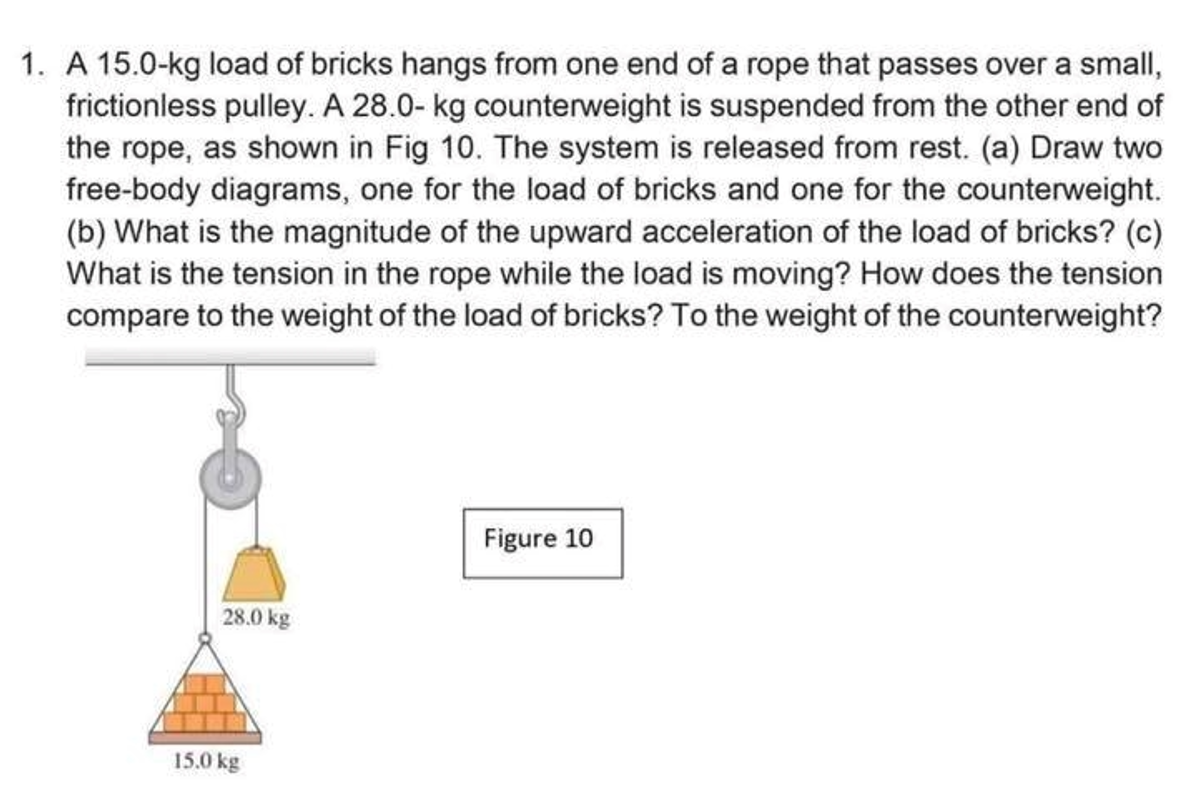1. A 15.0-kg load of bricks hangs from one end of a rope that passes over a small, frictionless pulley. A 28.0- kg counterweight is suspended from the other end of the rope, as shown in Fig 10. The system is released from rest. (a) Draw two free-body diagrams, one for the load of bricks and one for the counterweight. (b) What is the magnitude of the upward acceleration of the load of bricks? (c) What is the tension in the rope while the load is moving? How does the tension compare to the weight of the load of bricks? To the weight of the counterweight?
1. A 15.0-kg load of bricks hangs from one end of a rope that passes over a small, frictionless pulley. A 28.0- kg counterweight is suspended from the other end of the rope, as shown in Fig 10. The system is released from rest. (a) Draw two free-body diagrams, one for the load of bricks and one for the counterweight. (b) What is the magnitude of the upward acceleration of the load of bricks? (c) What is the tension in the rope while the load is moving? How does the tension compare to the weight of the load of bricks? To the weight of the counterweight?
Principles of Physics: A Calculus-Based Text
5th Edition
ISBN:9781133104261
Author:Raymond A. Serway, John W. Jewett
Publisher:Raymond A. Serway, John W. Jewett
Chapter5: More Applications Of Newton’s Laws
Section: Chapter Questions
Problem 46P: An aluminum block of mass m1 = 2.00 kg and a copper block of mass m2 = 6.00 kg are connected by a...
Related questions
Question

Transcribed Image Text:1. A 15.0-kg load of bricks hangs from one end of a rope that passes over a small,
frictionless pulley. A 28.0- kg counterweight is suspended from the other end of
the rope, as shown in Fig 10. The system is released from rest. (a) Draw two
free-body diagrams, one for the load of bricks and one for the counterweight.
(b) What is the magnitude of the upward acceleration of the load of bricks? (c)
What is the tension in the rope while the load is moving? How does the tension
compare to the weight of the load of bricks? To the weight of the counterweight?
Figure 10
28.0 kg
15.0 kg
Expert Solution
This question has been solved!
Explore an expertly crafted, step-by-step solution for a thorough understanding of key concepts.
This is a popular solution!
Trending now
This is a popular solution!
Step by step
Solved in 2 steps with 2 images

Knowledge Booster
Learn more about
Need a deep-dive on the concept behind this application? Look no further. Learn more about this topic, physics and related others by exploring similar questions and additional content below.Recommended textbooks for you

Principles of Physics: A Calculus-Based Text
Physics
ISBN:
9781133104261
Author:
Raymond A. Serway, John W. Jewett
Publisher:
Cengage Learning

College Physics
Physics
ISBN:
9781305952300
Author:
Raymond A. Serway, Chris Vuille
Publisher:
Cengage Learning

Physics for Scientists and Engineers, Technology …
Physics
ISBN:
9781305116399
Author:
Raymond A. Serway, John W. Jewett
Publisher:
Cengage Learning

Principles of Physics: A Calculus-Based Text
Physics
ISBN:
9781133104261
Author:
Raymond A. Serway, John W. Jewett
Publisher:
Cengage Learning

College Physics
Physics
ISBN:
9781305952300
Author:
Raymond A. Serway, Chris Vuille
Publisher:
Cengage Learning

Physics for Scientists and Engineers, Technology …
Physics
ISBN:
9781305116399
Author:
Raymond A. Serway, John W. Jewett
Publisher:
Cengage Learning

College Physics
Physics
ISBN:
9781285737027
Author:
Raymond A. Serway, Chris Vuille
Publisher:
Cengage Learning

College Physics
Physics
ISBN:
9781938168000
Author:
Paul Peter Urone, Roger Hinrichs
Publisher:
OpenStax College

Physics for Scientists and Engineers
Physics
ISBN:
9781337553278
Author:
Raymond A. Serway, John W. Jewett
Publisher:
Cengage Learning